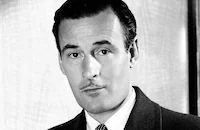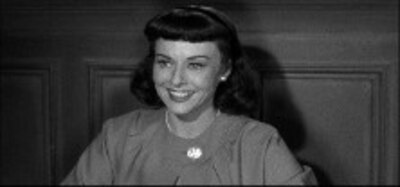Paris Model

Brief Synopsis
Cast & Crew
Alfred E. Green
Marilyn Maxwell
Paulette Goddard
Eva Gabor
Barbara Lawrence
Cecil Kellaway
Film Details
Technical Specs

Synopsis
At the exclusive Parisian designer shop Elissa de France, stylish socialite Gogo Montaine requests a unique gown for a forthcoming party, hoping to impress the Maharajah of Kim-Kepore. Chief couturier Berta Courtallez directs Gogo to a show that is being presented to a select group, who have been warned of the legal restrictions against copying the designs. During the show, Mark Richman, a buyer for Mason's of New York, introduces himself to Gogo, who politely refuses his request for dinner. Unknown to Berta, Richman's associate, Lisa Jones, is copying the design of the show's centerpiece, called "Nude at Midnight," a ravishing, bare-shouldered dress. Gogo selects the gown and charges the $890 price to a former lover, Louis-Jean Vacheron. That evening, Gogo and the Raj, are stopped by a policeman for speeding, but Gogo charms him into not giving them a ticket. At dinner, Gogo flirts with the Raj who remains distracted, despite her beautiful gown. When Louis-Jean arrives and refuses to pay for the dress, Gogo succeeds in enchanting him into changing his mind. At the gambling tables, Gogo is annoyed when the Raj is drawn to the beautiful croupier, despite losing his bet. When the Raj escorts the girl away, Gogo leaves with Jean-Louis, vowing to return the dress and get a refund for him.
Arriving in New York, Miss Jones takes the design of "Nude at Midnight" to Mason's to be reproduced. Meanwhile, at his office, attorney Edgar Blevins is nagged by his wife Cora about an upcoming dinner engagement and her need for a new dress, as Edgar's secretary, Betty Barnes, eavesdrops. Later, although Edgar attempts to concentrate on work, he is constantly distracted by Betty's legs. Confident she can manipulate Edgar's interest, Betty convinces him to take her dinner the following night. That afternoon, Betty hastens to Mason's and asks the saleswoman for a sexy dress, explaining that she hopes to seduce her boss into leaving his wife, not realizing that Cora is in the same shop listening. The saleswoman shows Betty the store's original copy of "The Nude at Midnight," which Betty eagerly purchases for $90. At dinner the following night, Edgar is appropriately impressed with Betty's dress and forgets to discuss work. Betty plies him with a number of martinis and nearly has convinced him to divorce his wife when Cora appears and, removing her coat, reveals she is wearing the same dress as Betty. Edgar is amazed at the change in his wife and leaves with her, to Betty's chagrin.
Across town, Marion Parmelee shops for a special gown for the retirement party of her husband's boss, Patrick James "P. J." Sullivan, inventor and designer of luxury beds. A sales clerk assures Marion that the dress she likes, "Nude at Midnight," is a $59 original copy of a copy of a Parisian design. Marion hurries to her husband Jack's office for the money and stops in to visit the aged, but charming P. J., with whom she flirts mildly, while suggesting he name Jack as his replacement. The night of the party, P. J.'s wife Nora cautions him to stay away from young, pretty women and looks forward to their retirement to Florida. Marion and Jack arrive, and P. J. is awed by Marion's provocative gown, which mortifies Jack's conservative co-worker, Ernest Boggs and his wife. P. J. invites Marion to his private office to see his latest design, and there flirts with Marion, who goes along good naturedly while insisting that P. J. appoint Jack as his replacement. Nora grows suspicious of P. J.'s long absence and begins the evening's tributes. When Jack demonstrates the latest bed design, P. J. and Marion, who have accidentally tumbled onto the bed in the next room, roll out in the display, annoying Nora. P. J. recovers and begins to announce his replacement, but Nora interrupts, pointing out that since her family's money started the business, she should be allowed to appoint the next president. When P. J. demurs, Nora picks Boggs, delighting him and his wife.
Across the country in Hollywood, California, Marta Jensen celebrates her twenty-first birthday with a special gown, another "Nude at Midnight" copy, purchased at a thrift shop for $19. She hopes to win a proposal from her longtime boyfriend, Charlie Johnson, with her mother and father's encouragement. Charlie takes Marta to the swank Romanoff's Restaurant and is miffed when he is refused a table, despite his twenty-five cent tip. Prince Michael Romanoff, the restaurant owner, is delighted by Marta's fresh beauty and her guileless fascination with the surroundings, so offers the young couple his private table. Charlie all but ignores Marta's conversation about homes and property, chattering away instead about the latest sports cars. When famed playboy Johnny Grandville arrives, Marta speculates about his nine marriages and Charlie scoffs at the institution. Annoyed, Marta finally gets the nerve up to remove her coat, and her dress stuns Charlie. Marta receives a note from the Maharajah of Kim-Kepore, seated nearby, asking her to dine with him. When she considers the invitation, Charlie finally breaks down and agrees to marry Marta. Marta then thanks the Raj and departs happily on Charlie's arm.

Director
Alfred E. Green
Cast

Marilyn Maxwell

Paulette Goddard

Eva Gabor

Barbara Lawrence

Cecil Kellaway

Robert Hutton

Leif Erickson

Tom Conway
"prince" Michael Romanoff

Florence Bates
El Brendel

Laurette Luez
Robert Bice
Aram Katcher
Gloria Christian

Byron Foulger
Bibs Borman
Paris Models
Crew
Dan Alexander
Robert Bice
Ralph Black
William Bradford
David Commons
Ida Forgette
William Glasgow
Albert Glasser
Albert S. Greenway
Larry Gross
W. Donn Hayes
Charles Keehne
Wilbur Kinnett
Anne Klein
Wilbur Mcgaugh
Ann Peck
Jack Rabin
Robert Smith
Earl Snyder
Alfred E. Spencer
Harry Thomas
Albert Zugsmith

Videos
Movie Clip


Film Details
Technical Specs

Articles
Paris Model (1953) - Paris Model
Eva Gabor, more famous as a high society celebrity than as an actress, starts the film off as a Paris socialite who lives off the generosity of older men with healthy bankbooks; she buys the dress (for a small fortune, which she charged to one of her admirers) to hook a rich Maharajah (Tom Conway, the brother of George Sanders) with a hopelessly bland personality. The role parodies Gabor's reputation and she embraces the comic part with verve and tongue-in-cheek guile.
The second story, about a seductive secretary trying to steal her boss away from his shrewish wife with the help of the dress (this time a knock-off of the original pirated by an unscrupulous New York fashion shop), stars the versatile, lively and still lovely Paulette Goddard. After a career that included the all-star actress showcase The Women (1939), three Cecil B. DeMille adventures and two Charlie Chaplin classics (Modern Times [1936] and The Great Dictator [1940]), her career was on the decline by 1953 but her comic talent is in fine form. Her sexy, slyly seductive performance (and frequent flashes of her shapely legs) helps overcome an otherwise unpleasantly mercenary character.
Top-billed Marilyn Maxwell, a curvaceous platinum blonde most famous for playing the lovely foil to Bob Hope, both onscreen (The Lemon Drop Kid [1951]) and in his USO shows, plays a married woman who purchases the dress (by now a second hand purchase from a middle-America dress shop) for a different kind of seduction: to woo a retiring company president (Cecil Kellaway) into picking her husband as his replacement.
Barbara Lawrence, the youngest of the film's leading ladies (she was groomed by 20th Century-Fox in such high-profile films as A Letter to Three Wives [1949] and The Star [1952]) anchors the fourth and final story as a sweet but frustrated California girl who dons the dress to encourage a proposal from her big-talking but commitment-shy boyfriend (Robert Hutton). The low-budget recreation of the legendary Hollywood eatery Romanoff's is unconvincingly cobbled out of curtains and stock furniture, but it co-stars the actual Prince Michael Romanoff as himself, the restaurateur playing cupid for the naïve lovebirds.
Producer Albert Zugsmith began his career with bargain basement exploitation movies like the post-apocalypse thriller Captive Women (1952) and the red scare film Invasion USA (1952). Paris Model, made for a more adult audience, is an upgrade in ambition and star power but just as budget-minded and he brought along Invasion USA director Alfred E. Green to help fake studio gloss on a low budget.
A journeyman director who had worked steadily since his directorial debut in the silent era, Alfred Green directed George Arliss to an Academy Award in the 1929 Disraeli. He also made the notorious Baby Face (1933) with Barbara Stanwyck, one of the sexiest and most salacious films of the early sound era before the production code, before settling into a career of mid-level productions. Paris Model was one of his last films before moving into television and his exhaustion shows. Zugsmith, however, was on his way up and he subsequently brought his formula of classy settings for exploitation projects to such films as Written on the Wind (1956), The Incredible Shrinking Man (1957) and Touch of Evil (1958).
Producer: Albert Zugsmith
Director: Alfred E. Green
Screenplay: Robert Smith
Cinematography: William Bradford
Art Direction: William Glasgow
Music: Albert Glasser
Film Editing: W. Donn Hayes
Cast: Marilyn Maxwell (Marion Parmalee), Paulette Goddard (Betty Barnes), Eva Gabor (Gogo Montaine), Barbara Lawrence (Marta Jensen), Cecil Kellaway (Patrick J. Sullivan aka P.J.), Robert Hutton (Charlie Johnson), Leif Erickson (Edgar Blevins), Tom Conway (Maharajah of Kim-Kepore), Aram Katcher (Louis-Jean Vacheron), Florence Bates (Mrs. Nora Sullivan).
BW-80m.
by Sean Axmaker

Paris Model (1953) - Paris Model
Quotes
Trivia
Notes
The working title of this film was Nude at Midnight. An Los Angeles Times news item adds Gilda Gray to the cast, but her appearance in the final film has not been confirmed. Contemporary sources indicate that Anne Klein designed the "Nude at Midnight" gown for Junior Sophisticates Co. of New York. Character actress Florence Bates made her final film appearance in the film. She died in December 1953.














